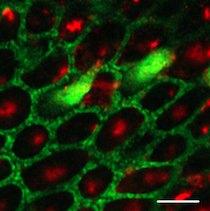Hearing testing in small animals
Providing assessment, technical expertise, and expert evaluation of hearing in mice and rats
Hearing tests provide information about the condition of the auditory (hearing) sensory system without having to sacrifice the animal. There are several different types of tests used in rodents to measure hearing sensitivity. A simple startle test can be done using a floating stage and a sound source. The animal will startle to abrupt sound until the sound is too low in intensity (threshold) or until the animal no longer feels the sound is a danger. This test is a rough estimate of whether the animal can hear and its value is limited. Two preferred tests for testing hearing in rodents are Otoacoustic Emissions testing (OAEs) and Auditory Brainstem Response testing (ABRs), also known as Brainstem Evoked Auditory Response testing (BEARs):
ABR Test
DPOAE Test
Histologic Analysis
Fees
Auditory Brainstem Response Test
ABR is the gold standard test for the detection of congenital or acquired deafness. ABR tests rely on the detection of neural responses to sound and can identify pathology in the ear or in the brainstem. Tiny electrodes pick up the neural responses from different sound stimuli presented to the ear at varying intensities, allowing the hearing loss to be classified as mild, moderate, or severe. The simplest form of ABR measures response to a click stimulus and can indicate if a hearing loss is present. A more complex ABR measures the response to a low (4 kHz) mid (16 kHz) or high (32 kHz) frequency can identify what component of the inner ear may be affected by hearing loss. The frequency information can translate directly to location of pathology when that pathology occurs within the inner ear. Latency shifts in the response waveforms can help define pathology in the auditory nerve or brainstem.
Distortion Product Otoacoustic Emissions (DPOAE) Test
OAEs are mechanical responses to sound that originate in the outer hair cells (sensory cells) of the inner ear. For this test, a miniature earphone and microphone are placed into the ear canal, sounds are played and a response is measured. If a subject hears normally, new sound is created within the sensory cell region in response to the sound presented. This new sound is reflected back into the ear canal and is measured by the microphone. The DPOAE is a particular type of OAE designed to look for pathology in the outer hair cells in specific areas of the inner ear. In the DPOAE, sound is swept from low frequency to high and the echo-like responses measured. When a subject has a loss of outer hair cell function in a particular region of the inner ear, no response can be measured from the frequency corresponding to that region
Histological Analysis
The gold standard for pathology of inner ear structures is histological analysis. This process takes more time to perform, but can give even more detailed information about condition of the inner ear, such as condition of support structures needed for proper sensory-neural transduction.
 Mouse utricle, stained for alpha-actinin
Mouse utricle, stained for alpha-actinin